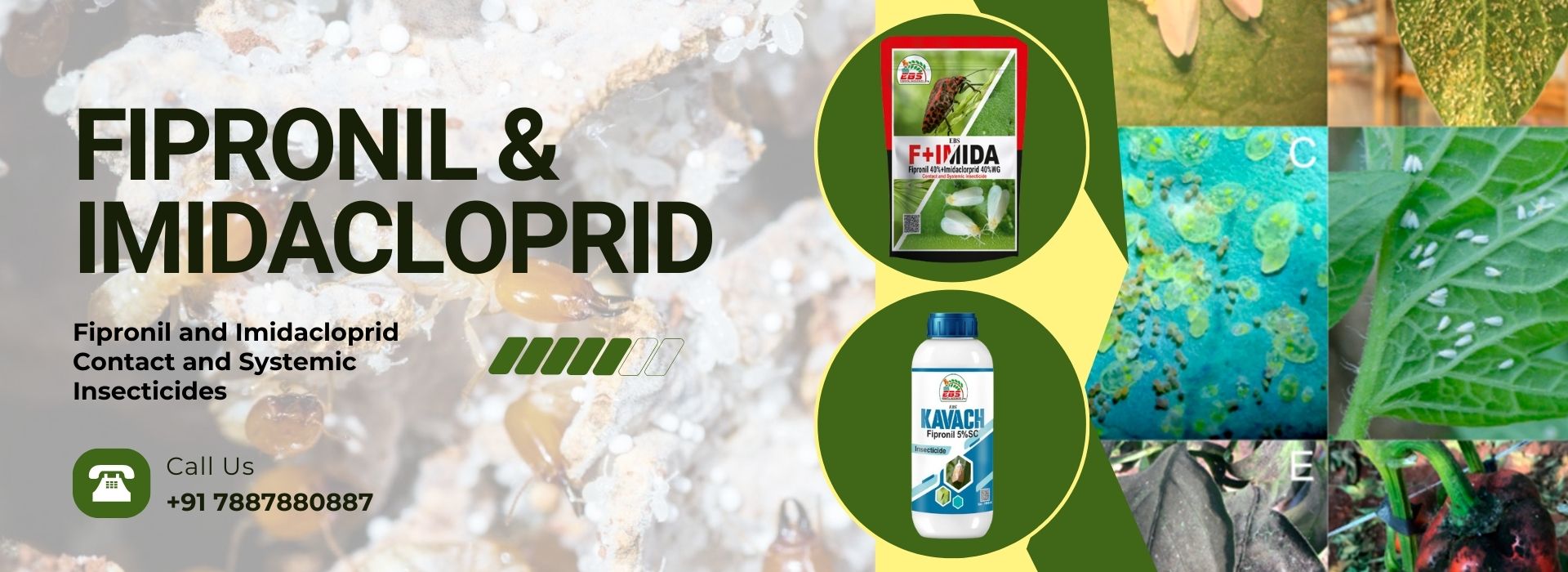The Battle Against Fungus-Growing Termites: Evaluating Fipronil and Imidacloprid Against Fungus-Growing Termites
July 24, 2024The Battle Against Fungus-Growing Termites:
Evaluating Fipronil and Imidacloprid Against Fungus-Growing Termites
The battle against fungus-growing termites is an ongoing challenge
faced by homeowners and pest control experts alike. These voracious pests can
wreak havoc on structures, leading to costly repairs and potential health
risks. In order to effectively combat these termites, it's essential to
evaluate the effectiveness of different pest control solutions.
Two commonly used insecticides, fipronil and imidacloprid, have
shown promise in eradicating fungus-growing termites. Fipronil is a
broad-spectrum insecticide that targets the central nervous system of termites,
effectively eliminating colonies. Imidacloprid, on the other hand, disrupts the
termites' ability to feed and reproduce, ultimately leading to colony collapse.
When considering which insecticide to use, it's important to weigh
factors such as effectiveness, safety, and environmental impact. Fipronil has a
longer residual effect and requires less frequent applications, making it a
favored choice in certain situations. Imidacloprid, on the other hand, is
considered to be less toxic to non-target organisms, making it a potentially
more environmentally friendly option.
In this article, we'll delve deeper into the battle against
fungus-growing termites, evaluating the efficacy of fipronil and imidacloprid,
and discussing the pros and cons of each. By understanding the strengths and
limitations of these insecticides, homeowners and pest control professionals
can make informed decisions to effectively combat these destructive pests.
Understanding the threat of fungus-growing
termites
Fungus-growing termites, also known as macrotermitine termites,
are a unique group of termites that have evolved a symbiotic relationship with
a specific fungus, Termitomyces. These termites are found primarily in Africa
and Asia, where they play a crucial role in the decomposition of wood and other
cellulosic materials in their natural habitats. However, when these termites
invade human-made structures, they can cause significant damage and pose a
serious threat to homeowners and property owners.
Fungus-growing termites are particularly destructive because they
don't just consume the wood, but they also cultivate the Termitomyces fungus,
which they use as a food source. This fungus-growing process allows the
termites to break down and digest even the toughest of cellulosic materials,
including structural timbers, furniture, and even paper products. As a result,
fungus-growing termites can cause extensive damage to buildings, leading to
costly repairs and potential safety hazards.
Furthermore, the presence of fungus-growing termites can also pose
health risks to occupants of infested structures. The Termitomyces fungus can
produce spores that can be harmful if inhaled, and the termites themselves can
also carry and spread various pathogens. This makes the control and eradication
of fungus-growing termites a critical issue for homeowners and pest control
professionals alike.
Overview of fipronil and imidacloprid as
termite control solutions
In the battle against fungus-growing termites, two insecticides
have emerged as promising solutions: fipronil and imidacloprid. Both of these
insecticides have been widely used in the pest control industry for their
effectiveness in controlling a variety of insect pests, including termites.
Fipronil is a broad-spectrum insecticide that targets the central
nervous system of termites and other insects. It works by disrupting the normal
function of the GABA-gated chloride channels, which are essential for proper
nerve and muscle function. This disruption leads to paralysis and ultimately
the death of the termites. Fipronil has a relatively long residual effect,
meaning that it can continue to be effective for an extended period after
application, making it a popular choice for termite control.
Imidacloprid, on the other hand, is a neonicotinoid insecticide
that targets the nicotinic acetylcholine receptors in the termites' nervous
system. This disruption interferes with the termites' ability to feed and
reproduce, ultimately leading to the collapse of the colony. Imidacloprid is
generally considered to be less toxic to non-target organisms compared to
fipronil, making it a potentially more environmentally friendly option for
termite control.
Effectiveness of fipronil against
fungus-growing termites
Fipronil has been extensively studied and proven to be highly
effective in controlling fungus-growing termites. One study conducted in South
Africa compared the efficacy of fipronil and other insecticides against the
fungus-growing termite, Macrotermes natalensis. The researchers found that
fipronil was the most effective, with a mortality rate of over 90% within 14
days of treatment.
The long-lasting residual effect of fipronil is a key advantage in
its use against fungus-growing termites. These termites can be particularly
challenging to control because they live in large, complex colonies that can be
difficult to penetrate. Fipronil's ability to remain effective for an extended
period after application allows it to continue to eliminate termites even as
they move through the treated areas.
Furthermore, fipronil has been shown to be effective against both
the worker and soldier castes of fungus-growing termites. This is important
because both castes play crucial roles in the colony's survival and
reproduction. By targeting both worker and soldier termites, fipronil can
effectively disrupt the entire colony, leading to its eventual collapse.
Overall, the research on the effectiveness of fipronil against
fungus-growing termites is quite promising, making it a valuable tool in the
battle against these destructive pests.
Effectiveness of imidacloprid against
fungus-growing termites
While fipronil has been the more extensively studied insecticide
for controlling fungus-growing termites, imidacloprid has also shown promise in
this area. Several studies have investigated the efficacy of imidacloprid
against various species of fungus-growing termites, with generally positive
results.
One study conducted in China examined the effects of imidacloprid
on the fungus-growing termite, Odontotermes formosanus. The researchers found
that imidacloprid was effective in reducing the survival and feeding rates of
the termites, even at relatively low concentrations. Additionally, imidacloprid
was observed to disrupt the termites' ability to cultivate their symbiotic
Termitomyces fungus, further compromising the colony's viability.
Another study, this time in India, focused on the effectiveness of
imidacloprid against the fungus-growing termite, Odontotermes obesus. The
results showed that imidacloprid-treated soil could effectively prevent the
termites from establishing new colonies and also reduced the size of existing
colonies over time. This suggests that imidacloprid can be a useful tool in
both preventive and curative measures against fungus-growing termites.
It's important to note that the effectiveness of imidacloprid may
vary depending on the specific species of fungus-growing termite and the
environmental conditions. However, the available research indicates that
imidacloprid can be a viable option for controlling these pests, particularly
in situations where a more environmentally friendly insecticide is preferred.
Comparing the efficacy of fipronil and
imidacloprid
When it comes to controlling fungus-growing termites, both
fipronil and imidacloprid have demonstrated their effectiveness, but with some
notable differences.
Fipronil generally exhibits a higher level of efficacy and a
longer residual effect compared to imidacloprid. This can be particularly
advantageous in situations where the termite infestation is severe or the
colony is well-established. Fipronil's ability to continue to eliminate
termites for an extended period after application can help ensure that the
entire colony is eradicated, reducing the risk of re-infestation.
On the other hand, imidacloprid is often considered to be less
toxic to non-target organisms, such as beneficial insects and wildlife. This
makes it a potentially more environmentally friendly option for termite
control, particularly in areas where there are concerns about the impact on the
surrounding ecosystem.
It's also worth noting that the effectiveness of these
insecticides can be influenced by factors such as the specific species of
fungus-growing termite, the environmental conditions, and the application
methods used. In some cases, a combination of fipronil and imidacloprid may be
more effective, as they can target different aspects of the termite colony's
biology and behavior.
Ultimately, the choice between fipronil and imidacloprid for
controlling fungus-growing termites will depend on the specific needs and
priorities of the homeowner or pest control professional. Factors such as the
severity of the infestation, the environmental concerns, and the long-term
effectiveness of the treatment should all be carefully considered.
Factors to consider when choosing a termite
control solution
When it comes to combating fungus-growing termites, the choice of
a termite control solution is not a one-size-fits-all decision. Several factors
must be taken into account to ensure the most effective and appropriate course
of action.
One of the primary considerations is the severity and extent of
the termite infestation. If the colony is well-established and the damage is
extensive, a more potent and long-lasting solution like fipronil may be the
best choice. Conversely, if the infestation is in its early stages or the
environmental impact is a greater concern, imidacloprid may be the more
suitable option.
Another crucial factor is the specific species of fungus-growing
termite present. Different termite species may have varying levels of
susceptibility to different insecticides. Consulting with a professional pest
control expert can help determine the most effective approach based on the
identified termite species.
The location and surrounding environment of the infested structure
are also important factors. In areas with sensitive ecosystems or proximity to
bodies of water, the environmental impact of the chosen insecticide may be a
more significant consideration. In such cases, a more environmentally friendly
solution like imidacloprid may be the preferred choice.
Additionally, the long-term effectiveness and cost of the
treatment should be weighed. Fipronil's longer residual effect may require
fewer applications, potentially making it a more cost-effective option in the
long run. However, the initial cost of the treatment and any potential safety
or environmental concerns must also be taken into account.
By carefully considering these factors, homeowners and pest
control professionals can make an informed decision on the most appropriate
termite control solution for their specific situation, ensuring the best
possible outcome in the battle against fungus-growing termites.
Other methods for controlling fungus-growing
termites
While insecticides like fipronil and imidacloprid are widely used
in the battle against fungus-growing termites, there are also other methods and
approaches that can be employed to control these pests.
One alternative method is the use of biological control agents,
such as predatory ants or nematodes. These natural enemies of termites can be
introduced to the infested area, where they can help to reduce the termite
population and disrupt the colony's overall functioning.
Another approach is the use of physical barriers, such as
termite-resistant building materials or physical treatments like borate-based
wood preservatives. These methods aim to create a physical obstacle that
prevents the termites from accessing and damaging the structure.
In some cases, the removal and replacement of infested structural
elements may be necessary to completely eliminate the termite colony and
prevent further damage. This can be a more invasive and costly approach, but it
may be the only viable option in severe infestations.
Additionally, integrated pest management (IPM) strategies that
combine multiple control methods, such as insecticides, physical barriers, and
monitoring, can be highly effective in managing fungus-growing termite
populations. By using a multi-pronged approach, pest control professionals can
target the termites' vulnerabilities and disrupt the colony's overall
functioning.
It's important to note that the choice of control method(s) will
depend on the specific situation, the severity of the infestation, and the
preferences and constraints of the homeowner or pest control professional. A
comprehensive evaluation of the problem and a tailored approach are often
necessary to achieve the best results in the battle against fungus-growing
termites.
Professional termite control services for
fungus-growing termites
When it comes to controlling fungus-growing termites, homeowners
and property owners often turn to professional pest control services for their
expertise and specialized equipment. These professionals have the knowledge,
experience, and resources to effectively identify, treat, and manage termite
infestations, ensuring the best possible outcome for the property.
Professional pest control companies typically employ a range of
techniques and strategies to combat fungus-growing termites. This may include
thorough inspections to identify the extent of the infestation, the application
of insecticides like fipronil or imidacloprid, the use of physical barriers or
bait systems, and ongoing monitoring to prevent re-infestation.
One of the key advantages of professional termite control services
is their ability to tailor the treatment approach to the specific needs of the
property and the type of termite infestation. They can assess the severity of
the problem, the structural integrity of the building, and the potential
environmental impact, and then develop a comprehensive plan to address the
issue effectively.
Additionally, professional pest control companies often have
access to specialized equipment and products that may not be readily available
to homeowners. This can include advanced application methods, such as sub-slab
or deep-soil injections, which can reach and eliminate termite colonies that
are difficult to access.
Perhaps most importantly, professional pest control experts can
provide ongoing monitoring and maintenance services to ensure that the termite
problem is fully resolved and does not recur. This can give homeowners and
property owners peace of mind, knowing that their investment in termite control
is protected in the long term.
While the cost of professional termite control services may be
higher than DIY solutions, the expertise, resources, and long-term benefits
often make it a worthwhile investment for those facing the threat of
fungus-growing termites.
Conclusion: Choosing the right solution for
combating fungus-growing termites
The battle against fungus-growing termites is an ongoing challenge
that requires a multifaceted approach. As homeowners and pest control
professionals navigate this complex issue, the choice of the right termite
control solution is crucial.
Fipronil and imidacloprid have both emerged as effective
insecticides in the fight against fungus-growing termites. Fipronil's potency
and long-lasting residual effect make it a valuable tool in eradicating
well-established colonies, while imidacloprid's relatively lower environmental
impact can be a more appealing option in certain situations.
When deciding between these two insecticides, it's essential to
carefully consider the specific factors at play, such as the severity of the
infestation, the surrounding environment, and the long-term cost-effectiveness
of the treatment. Consulting with a professional pest control expert can help
homeowners and property owners make an informed decision that best suits their
needs and priorities.
Beyond insecticides, there are also other methods and approaches
that can be employed to control fungus-growing termites, including the use of
biological control agents, physical barriers, and integrated pest management
strategies. The combination of these techniques can often provide the most
comprehensive and effective solution.
Ultimately, the key to successfully combating fungus-growing termites lies in a multi-pronged approach that leverages the strengths of various control methods, while also taking into account the unique circumstances of each situation. By staying informed and working with experienced professionals, homeowners and property owners can take proactive steps to protect their investments and safeguard their properties from the devastating effects of these destructive pests.
At krishibazaar.in, you can find and buy various
agricultural products. For agricultural guidance on selecting the most suitable
products for your crops, please contact or WhatsApp at +917887880887.






Guest reviews
No reviews found for this Blog